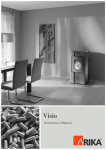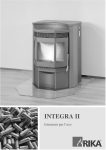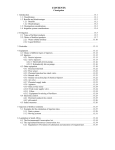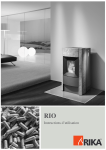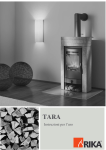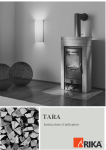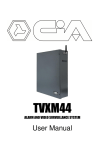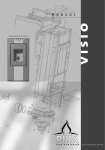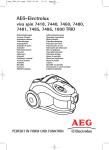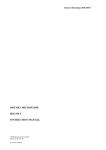Download RIKA INTEGRA II Instruction manual
Transcript
INTEGRA II Instruction Manual -1- -2- 22 Fig. 3 -3- -4- CONTENTS Technical specification and spare parts overview 7 1. IMPORTANT INFORMATION 8 2. WHAT ARE PELLETS? Specification for high-quality pellets Pellet storage 8 8 8 3. TECHNOLOGY 9 4. AUTOMATIC SAFETY FUNCTIONS Power failure Overheating Low temperature switch off Electrical excess current switch off 5. 6. 7. 8. 9. 9 9 9 9 INSTALLING THE STOVE General information Making the chimney connection Method Floor protection Safety distances Electrical connection Combustion air Feed of external combustion air 10 10 10 10 11 11 11 11 FITTING THE PANELLING, OPTIONS General Side panel Control and operating board 12 12 12 OPERATION Basic information Control and internal control unit – function Internal control unit 13 13 13 UNIT COMMISSION ING/CONTROL PROGRAMMING/CONTROL OPTIONS General First commissioning/program settings Main menu operating areas Shut down unit Shut down from “Manual operation (ON)” Shut down unit from automatic operation Automatic stop controlled by heating time Automatic stop, manual Shut down by operating mode in Standby Pellet control (optional) room temperature sensor Tele-Control (telephone control optional) 14 14 17 17 17 19 19 19 19 19 19 ELECTRICAL IGNITION Pre-heating without electrical ignition Some field values Fuel feed 20 20 20 -5- 10. CLEANING AND MAINTENANCE Basic Information Cleaning the fire tray Cleaning the grate door glass Cleaning the flue gas channels Cleaning exhaust gas collector Cleaning exhaust gas fan housing Cleaning pellet container Inspecting door seal Checking chimney connection Cleaning air sensor 21 21 22 22 22 23 23 23 23 23 11. FAULTS – CAUSES - SOLUTIONS Error messages control 24 12. ATTACHMENT Navigation to programme the internal control system 26 13. LIST OF HEADINGS AND ABBREVIATIONS 27 14. WARRANTY We guarantee Warranty card 29 32 Subject to technical and visual changes; setting and printing errors excepted. EXPLANATION OF SYMBOLS Important information Practical advice Use the plan -6- SPARE PARTS - OVE RVIEW (Fig. 1) (Fig. 2 - Fig. 5) TECHNICAL DATA Height Width Depth of the corpus Weight without casing Flue pipe outlet diameter Heat output range Room heating capacity (m3) depending on house insulation Fuel consumption Pellet container capacity Mains connection Average electrical power consumption Protection Efficiency CO2 content CO emission rel. 13% O Dust emissions Exhaust mass flow Exhaust temperature Draught requirement DESCRIPTION [mm] [mm] [mm] [kg] [mm] [kW] 950 724 652 155 100 2,5 - 9 [m3] 50 - 240 [kg/h] [kg] [V]; [Hz] 0,7 – 2,2 62 230/50 [W] < 100 [A] [%] [%] [mg/Nm3] [mg/Nm3] 1.6 T 85,7 8,8 136 22 [g/s] [°C] [Pa] 9,2 178 0 01 Glass ceramic side 02 Glass ceramic front 03 Cast iron door 04 Screw handle 05 Door handle 06 Conveyor auger cover 07 Heat guard 08 Cleaning lid incl. seal 09 Conveyor helix 10 Motor plate 11 Auger drive motor 12 Gear guard 13 Container lid 14 Lid ceramic 15 Lid plate 16 Air sensor 17 Decorative ring 18 Ash pan 19 Combustion chamber 21 Flue plate bottom 22 Insulation plate 23 Flue plate top 24 Excess temperature switch 25 Edge plate of door welded 27 Main board 28 Tele-Control (optional) 29 Mains cable 30 Adapter for flue gas fan 31 Locking ring 32 Low temperature switch 33 Seal for low temperature switch 34 Flue gas fan - blower complete 35 Flue gas fan motor with Hall IC 36 Convection fan 37 Hinge top 38 Hinge bottom 39 Heating element for electric ignition 40 Assembly tube for heating element 41 Side cladding left 42 Cladding left back 43 Base 44 Cladding right back 45 Control board 46 Side cladding right 47 Cover The owner of the small heating system or the authorised person for the small heating system must keep the technical documentation in a safe place and present it to the local authority or the chimney sweep if required. 1. PACKAGING Your first impression is important to us! The packaging for your new stove provides excellent protection against damage. However damage to the stove and accessories can occur during transport. Therefore please check that your stove is undamaged and that all parts are there on receipt! - The packaging for your new stove generally has no effect on the environment. The box and the film (PE) can be safely taken to the local council waste disposal depot for recycling. Please observe the national and European standards as well as local regulations concerning the installation and operation of firing installations! -7- ENGLISH TECHNICAL SPECIFICATION ENGLISH 1. IMPORTANT INFORMATION ● Make children aware of the danger and keep them away from the stove when in use. GENERAL WARNING AND SAFETY INSTRUCTIONS ● Placing non heat resistant objects on the stove or nearby is prohibited. The general introductory warning information must be followed. ● Do not lay washing on the stove to dry. ● Read the whole of the manual thoroughly before commissioning the stove. ● Stands for drying items of clothing or suchlike must be set up at an adequate distance from the stove – fire hazard! ● Only approved transport aids with adequate load bearing capacity must be used for transporting your stove. ● When your stove is burning, the use of highly inflammable and explosive materials in the same or adjacent rooms is prohibited. ● Your stove is not suitable for use as a ladder or scaffold. ● ATTENTION!! In cause of safety reason please do not open the combustion chamber door during operation! ● The burning of fuel releases heat energy that leads to extensive heating of the stove surfaces, doors, door and operating handles, glass, flue pipes and possibly the front wall. Refrain from touching these parts without appropriate protective clothing or equipment e.g. heat-resistant gloves or means of operation (operating handle) ● CAUTION when filling the storage container. The opening of the pellet container is sufficient to ensure problem-free filling. Ensure that no pellets fall on the convection ribs and the hot stove body. This can otherwise lead to heavy smoke formation. We therefore recommend refilling the storage container when the stove is cold. -8- Wood pellets are a standardised fuel. Every manufacturer must adhere to certain conditions in order to enable flawless, energy-efficient heating. Pellets are made from wooden waste, from sawmills and planning workshops, as well as from residue from forestry operations. These “starting products” are crushed, dried, and pressed into Pellet “Fuel” without any bonding agent. are reviewed every year. A quality assurance system ensures the pellets comply with the requirements of the new standard and that the conditions for trouble-free heating are guaranteed. Please request tested fuel and a list of monitored fuel manufacturers from your pellet stove dealer. Use of poor quality or non-approved pellet fuel impairs the function of your stove and may lead to lapsing of the warranty, guarantee and associated product liability. Observe the ban on incinerating waste! Only burn pellets that have been inspected according to ÖNORM, DIN Plus or ENplus-A1. ENplus – Pellets This new pellets are a standard sets new benchmarks in the European pellet market. The traceability of pellets is ensured thanks to the use of identification numbers. The pellet manufacturers’ production facilities and manufacturing processes WOOD PELLET SPECIFICATION according to ENplus – A1 Parameter Diameter Length Bulk density Calorific value Water content Fine fraction (< 3.15 mm) Mechanical rigidity Ash content Ash softening temperature Chlorine content Sulphur content Nitrogen content Copper content Chrome content Arsenic content Cadmium content Mercury content Lead content Nickel content Zinc content 1) 2) 3) 4) Unit mm mm kg/m³ MJ/kg Ma.-% Ma.-% Ma.-% 1) Ma.-% (DT) °C 1) Ma.-% 1) Ma.-% 1) Ma.-% 1) mg/kg 1) mg/kg 1) mg/kg 1) mg/kg 1) mg/kg 1) mg/kg 1) mg/kg 1) mg/kg ENplus-A1 2) 6 (±1) 3) 3.15 to 40 ≥ 600 ≥ 16.5 ≤ 10 ≤1 4) ≥ 97.5 ≤ 0.7 ≥ 1200 ≤ 0.02 ≤ 0.03 ≤ 0.3 ≤ 10 ≤ 10 ≤1 ≤ 0.5 ≤ 0.1 ≤ 10 ≤ 10 ≤ 100 in an anhydrous state Diameter must be specified a maximum of 1% of the pellets may be longer than 40 mm; max. length is 45 mm The limit value of ≥ 97.7 Ma.-% applies when conducting measurements with a Lignotester (internal control) PELLET STORAGE In order to guarantee problem free burning of the wooden pellets, it is imperative necessary to store the fuel as dry as possible and free from impurities. NOTE: Waste and liquids may not be burnt in the stove! Pellets should not be kept in sacks outdoors or stored in a manner where they are exposed to the environment. This can lead to blockages in the screw conveyor - "screw stoppers" are excluded from the warranty. -9- ENGLISH 2. WHAT ARE PELLETS? ENGLISH 3. TECHNOLOGY Your operating outlay is reduced to the most necessary - this prevents operating faults whilst working in an optimum fashion at the same time. Your new pellet stove is technologically advanced as a result of years of tests in the laboratory and in practice. The practical advantages of your pellet stove are convincing: – HIGHEST EFFICIENCY - LOWEST EMISSIONS The electronic monitoring device together with a patented “air sensor” controls and regulates the interplay of flue gas fan, conveyor auger, convection fan and temperature. This monitoring system guarantees an optimum combustion and operating mode. A very large heat exchanger surface togetherwith optimum combustion air control leads to very good fuel usage. Finely metered pellet feed in an optimised burner pot made from high quality grey cast iron effects almost perfect combustion with very good exhaust gas values - and this is guaranteed in every operating phase. OPERATING COMFORT OPERATIONAL RELIABILITY 4. AUTOMATIC SAFETY FUNCTION A taking-out-of-service program (cleaning, follow-up phase) is performed. The stove must be restarted depending on the pre-set mode. POWER FAILURE After a short power failure the operating functions that were set before the power failure are continued. ON mode (manual operation). The control switches to the ST (Start Phase) and the unit then re-runs in ON operation. TM mode (automatic operation). The control switches to the ST (Start Phase) and the unit then re-runs in TM operation. SB mode (operational readiness, standby operation). After two seconds the control re-runs in the SB operation. CAUTION: If overheating has occurred then maintenance or cleaning work must be carried out. LOW TEMPERATURE SWITCH OFF If the stove cools down below a minimum temperature, then the stove will switch off. This switch off can also occur if pre-heating is too slow. On power failure a small amount of smoke may be shortly emitted. This does not represent a safety risks. ELECTRIC SHUT OFF OVERHEATING A temperature safety switch (STL) switches the stove off automatically if it overheats. EXCESS-CURRENT The device is protected against excess current by a main fuse (on the rear of the device), (see “Technical Specification”). - 10 - GENERAL INFORMATION MAKING THE CHIMNEY CONNECTION The stove must be connected to a chimney that is approved for solid fuels. The chimney must have a diameter of at least 120 mm. The flue system is based on negative pressure in the combustion chamber and a slight overpressure on the flue gas outlet. It is therefore important that the flue gas connection is fitted correctly and is airtight. (Fig. 1) Method 1. Measure and draw the chimney connection (taking any floor plate thickness into consideration). (Fig. 1) We recommend determining the dimension of the flue pipe discharge directly at the oven. 2. Chisel out (drill) the hole in the wall 3. Brick in the wall lining 4. Connect stove with the flue tube to the chimney. Only use heat resistant sealing materials, as well as the relevant sealing bands, heat resistant silicon and mineral wool. Only authorised technical personnel must carry out assembly work. FLOOR PROTECTION In addition you must ensure that the flue tube does not project into the free cross section of the chimney. For flammable floor surfaces (wood, carpet, etc.) a glass, steel plate or ceramic underlay is required. NOTE: Please follow the regionally valid building regulations. Contact your master chimney sweep for information on this. Ensure that outlet routes to the chimney are not too long. Avoid too many changes of direction for the flue gas flow to the chimney. (e.g. too many corners and bends). Don’t exceed a maximum of 3 bends in the flue pipe. Where you cannot connect directly to the chimney, if possible use a connection piece with cleaning opening. For optimum efficiency please use the type of connector we recommend. SAFETY DISTANCES (Measured from the outside of the stove) From non-combustible objects a = on the side & back > 100 mm b = on the front > 400 mm From combustible objects and to load-bearing walls in reinforced concrete a = on the side & back > 200 mm b = on the front > 800 mm - 11 - ENGLISH 5. INSTALLING THE STOVE ENGLISH Feed of external combustion air ELECTRICAL CONNECTION ● Steel, HT or flexible aluminium pipes must be used. ● Minimum diameter 5 cm/2 inches. ● For longer connection runs the diameter must be increased to approx. 10 cm after approx. 1 m. ● The pipe should not be longer than approx. 4m in total to guarantee adequate air feed and not have too many bends. ● Should the line lead into the open air, it must end with a vertical 90° downward elbow or with a wind guard. The stove is supplied with an approx. 2.5 m long connecting cable with a plug. The cable must be connected to a 230 V, 50 Hz electrical supply. The average electric power consumption is approx 100 watts during heating. During the automatic ignition process (duration 10 minutes) approx. 350 watts. The connection cable must be laid so that any contact with hot or sharpedged external surfaces on the stove is avoided. COMBUSTION AIR Should one or more of these conditions NOT be applicable then usually poor combustion will occur in the stove, as well as air underpressure in the apartment. Each combustion procedure requires oxygen or air. As a rule this combustion air is removed from the living area for individual stoves The air taken from the living area must be reintroduced. In modern houses, very tight fitting windows and doors mean that too little air flows back. This situation becomes problematic due to additional ventilation in the house (e.g. in the kitchen or WC). If you cannot feed in external combustion air, then air the room several times a day to prevent negative pressure in the room or poor combustion. Further it is possible to extract the combustion air directly from outside or from another room that is well ventilated (e.g. the cellar). Please observe: Your pellet stove works independent of the room air. Negative pressures in the set-up room are not permissible. Therefore the use of a safety device (e.g. differential pressure controller) in combination with room air facilities (e.g. ventilation system, exhaust extraction etc.) is stipulated. The suctioning in of combustion air is performed via the flue gas blower. The resulting combustion air and suctioning noises are normal operational noises that may occur at varying volumes depending on the chimney draught, output level or a dirty combustion trough – NOT A CAUSE FOR COMPLAINT! Note: Please note that problems may arise due to updrafts in the case of combustion air supply from an integrated chimney ventilation shaft. If the combustion air flowing downwards is heated it may rise and thus counter the chimney with a resistance which in turn reduces the negative pressure in the combustion chamber. The chimney manufacturer is to guarantee that the resistance for the combustion air is a maximum 2 Pa even in the least favourable operating state of the chimney. Minimum diameter 5 cm / 2 inch Wall - 12 - ENGLISH 6. ASSEMBLY OF PANELS, OPTIONS GENERAL CAUTION! Only work on the unit when the mains plug has been disconnected. Your stove must be switched off and cooled before any work is performed. Do not allow objects (screws etc.) to fall into the fuel container – they can block the screw conveyor and damage the stove. SIDE PANEL 1. Insert the side sections in the receiving seat provided on the bottom section. 2. Push the side section against the stove until it is vertical. 3. Then fasten with two screws in the pellet container Repeat on the other side of the stove. CONTROL BOARD AND OPERATING The INTEGRA II pellet stove has an internal electronic control system located in the stove and an operating board attached to the stove panels. Work on the control system (mainboard) and the operating board may only be performed by trained specialist dealers or service technicians. Incorrect handling of these parts leads to loss of warranty. - 13 - ENGLISH 7. OPERATION BASIC INFORMATION INTERNAL CONTROL UNIT The stove must only be started when fully fitted. All settings and functions can be regulated via this unit. Your pellet stove is exclusively for burning pellets made from wood of a controlled quality. Non-pelletised solid fuels (straw, maize, chopped matter etc.) are not permitted. Failure to adhere to these guidelines will make all guarantee and warranty claims null and void and could have a negative effect on the safety of your stove. When operated correctly your pellet stove cannot overheat. Improper operation can however shorten the life expectancy of the electric stove components (fan, motors and electric control) and is not permitted. CONTROL AND INTERNAL CONTROL UNIT - FUNCTION Your pellet stove is fitted with a modern programmable microprocessor control. The user can preset the individual stove functions via the internal control unit (keypad with operating display) fitted at the top of the right hand stove panel. Fig 1. Internal operating unit, key layout DISPLAY PANEL: Display of operating state in illuminated text The control (main board) and the control board may only be altered by trained specialist dealers or the service department. Improper handling of these parts leads to the guarantee and warranty becoming null and void. MENU: Navigation in and to the various sub-menu levels ENTER: Navigation in the main menus (SB, ON, TM) and confirmation of use inputs MINUS/PLUS: Decrease and increase of user values ON/OFF: Switching unit on and off For a graphical representation of the menu navigation of the program levels see Appendix, page 29. - 14 - Now press “ENTER” and the display shows: GENERAL ● Check that the pellet container is full and the combustion chamber is clean and contamination free. “S1” = start first heating time, 6 the number is the time in hours (0 to 23 hours) e.g. see window 6 Hour. CAUTION: During the ignition process the grate door must be closed. The electronic ignition does not work if the grate door is open. By pressing the “+” or “-” keys the heating time can be changed in hourly steps as required. The desired value is confirmed with “ENTER” and is then saved. The display shows When the pellet container of the stove is filled for the first time, no pellets are conveyed to the fire tray for about 10 minutes. You can put a handful of pellets in the fire pan to avoid a new start process. FIRST COMMISSIONING/ PROGRAMME SETTINGS “E1” = end of first heating time, After filling the supply container and connecting the stove to the mains electrical supply, press the ON/OFF key on the internal operating unit and SB (Standby) is displayed. By pressing the “+” or “-” keys the heating time can be changed in hourly steps as required. The desired value is confirmed with “ENTER” and is then saved. The display shows “SB” = standby operation “S2” = start of second heating time, Now program your control for your individual requirements as follows: (See page 29 for menu navigation). Two heating intervals can be programmed for each weekday. No heating times are programmed in the factory. Press “MENU” on the operating unit and the display shows the following: After entering the second heating time confirming with “ENTER” the display shows and “E2” = end of second heating time, “MO” = Monday After entering the switch off point of the second heating time and confirming with “ENTER” the new valued is saved and the display now shows: - 15 - ENGLISH 8. DEVICE COMMISSIONING / CONTROL PROGR AMMING / CONTROLOTIONS ENGLISH If you want to maintain a specific heating output (low operation) between the programmed heating times you can set the required value by pressing the “+” or “-” keys. On selecting the “MENU” key the display shows the following weekday: “TU” = Tuesday, The number equals the heating output in percent (e.g. see window 5%). Press the “ENTER” key to return to the starting point of the first heating time for Tuesday. Press the “ENTER” key to save the PE value, the display shows: Proceed to enter the rest of the heating times for the weekdays (Wednesday “WE”, Thursday “TH”, Friday “FR”, Saturday “SA”, Sunday “SU” as described above. To improve combustion quality, automatic cleaning of the fire pan is programmed into the control process After acknowledgement with “ENTER” of the E2 value of Sunday (SU) and selection of “MENU” the display shows: “CL” = Clean the number indicates the time interval in minutes (e.g. see window 60 Minutes). “PS” (Power Start) = heating output during the programmed heating times (S1-E1, S2-E2). By pressing the “+” or “-” keys you can determine the desired time interval in 5 minute steps (The cleaning interval can be extended to 300 minutes, however we recommend a cleaning cycle of 60 minutes). Confirm with “ENTER” and the display shows: The number corresponds to the heating output in percent (0% equals minimum heating output, 100% equals maximum heating output). By pressing the “+” or “-” keys you can change the value of the heating output in 5% steps as required. The value is confirmed with “ENTER” and the display shows VA 1.28 “PE” (Power End) = heating output between the programmed heating times (E1-S2). This is the current software version of the control and is used for customer service reasons (display only). Now use “MENU” to access the internal clock and the following display appears: “H” = Hour the number indicates the hour (value range 0 to 23). “OFF” indicates that the stove is switched off between the programmed heating times. The value “OFF” is achieved by pressing the “-” key until “OFF” is displayed. - 16 - “PN” The number 8 (see window) represents the second digit of the PIN code: “M” = Minutes, the number indicates the minutes (value range 0 to 59). Press the “+” or “-” keys to select the required value and confirm with “ENTER”, the display then shows: Set the minutes of the system clock to the correct value by pressing the “+” or “-” keys and confirm with “ENTER”. The value is then saved and the display shows: “PN” The number 1 (see window) represents the third digit of the PIN code: “D” = Day, the number indicates the weekday, e.g. see window 3 = Wednesday. Press the “+” or “-” keys to select the required value and confirm with “ENTER”, the display then shows: Set the current weekday (1 = Monday, 2 = Tuesday, 3 = Wednesday, 4 = Thursday, 5 = Friday, 6 = Saturday, 7 = Sunday) by pressing the “+” or “-” keys and confirm the new value by pressing “ENTER”. The value is then saved and on pressing “MENU” the display shows: “PN” The number 5 (see window) represents the fourth digit of the PIN code: a) if the optional Tele-control is installed Press the “+” or “-” keys to select the required value and confirm with “ENTER”. Then select “MENU” and you return to the main menu and the display shows: “RI” = Rings The number of ring tones can be set from 1 to 10. “SB” = Standby By pressing the “+” or “-” keys the number of rings can be changed. Press “ENTER” to confirm and the value is then saved and the display shows: Now the stove has been programmed according to your individual requirements you can set it to manual mode (ON mode) by a single press on the “ENTER” key or to automatic mode (TM mode) by double pressing the “ENTER” key “PN” means PIN-Code (Personal Identification Number) 4-digit. The number 0 (see window) represents the first digit of the PIN code (0 - 9 possible): - 17 - ENGLISH Select the desired value by pressing the “+” or “-” keys and confirm with “ENTER”. The display then shows: By pressing the “+” or “-” keys the current hour of the internal clock can be set. The desired value is confirmed with “ENTER” and is then saved. The display shows ENGLISH Ensure that when the stove is in ON mode the heating operation starts after 10 seconds. In automatic mode (TM) the heating process starts in accordance with the programmed heating times. MAIN MENU RANGES – Start manual operation. The following flashing indicators appear alternately on the display OPERATING According to your requirements you can choose one of the following three operating types: ● Standby mode “ST” indicates start The number below indicates the remaining time for the start process in minutes. On completion of the start phase the following appears continuously on the display “SB” = Standby Stove is switched off but remains active for control by Tele-Control (Telephone). “ON” = Manual operation ● Manual operation “ON” = Manual operation The number equals the heating output in percent (0% is minimum output and 100% is maximum heating output). If you want to change the current heating output then you can set the required heating output in 5% steps (from 0 to 100) by pressing the “+” or “-” keys. ● Automatic operation “TM” = Automatic operation(Time mode) The number equals the heating output in percent (0% is minimum output and 100% is maximum heating output. You can switch between the various operating types by pressing “ENTER” - 18 - PLACE STOVE OUT OF OPERATION When TM is selected on the display and the programmed heating time begins the control starts the heating operation. Switching off from “Manual operation” (ON) If the “ON/OFF” key is pressed during operation then the switch off program is activated. The following alternating flashing indictors appear on the display: The following flashing indications appear alternately on the display: “TM” indicates automatic operation. “Ex” Exit phase 1 The number below is the remaining time in seconds for this phase. On completion of the start phase the following appears continuously on the display On completion of Exit phase 1 the display shows (flashing): Generally the pre-programmed heating output (PS, PE) is adopted. If however youwant to change the current value, then this can be done by pressing the “+” or “-” keys in 5% steps. The changed value appears on the display. The program adopts the new value for the control until the completion of the current heating window. On starting the following heating time the programmed value is re-used. A permanent change of heating output can only be achieved by programming PS and PE. “CL” Cleaning phase The number below is the remaining time in seconds for this phase. On completion of Exit phase 1 the display shows (flashing): Note: The pre-heating program runs automatically and can be stopped by changing (“ENTER” key) the operating state to “SB”. In this case the out of operation mode (alternating indication “Ex”, see below) runs through to the end. If the stove is disconnected from the mains supply (i.e. power cut) during the start phase and then re-connected to the mains supply, the start phases starts from the beginning again. “Ex” Exit phase 2 The number below is the remaining time in seconds for this phase. Note: The full switching off process lasts for about 8 minutes and cannot be interrupted by the user. On confirmation of “ON/OFF” the switch off program is initialised. - 19 - ENGLISH Start automatic operation (TM mode) ENGLISH On completion of the switch off program the display goes off. When the “ON/OFF key is pressed a restart follows. SWITCHING OFF AUTOMATIC OPERATION SWITCHING OFF BY CHANGING OPERATINGMODE IN STANDBY If you change to the Standby mode by pressing the “ENTER” key in “Manual operation” and in automatic operation, then switching off as described in the processabove will be carried out. On completion of the switching off program the following display appears: STOVE Heating time controlled automatic stop If during automatic operation the “PE” output is switched to OFF, then the stove will be switched off at the end of a heating time as per the abovedescribed functions. The difference to manual switch off is that TM is displayed instead of ON. “SB” = Standby On completion of the switch off process the following is displayed: To re-start the stove a corresponding mode must be selected or the stove must be started with the optional Tele-Control (telephone start). “TM” = Automatic operation (Time mode) OFF switches off heating operation. PELLET CONTROL (OPTIONAL) ROOM TEMPERATURE SENSOR Using the external operating unit your pellet stove functionality can be extended by the room temperature control. This means that the room temperature is measured by a sensor in the external operating unit. The function is not part of the standard delivery and can be retro-fitted if desired. The corresponding extended functions of the stove and the programming of the system values are contained in the retro-fitting instructions. A pre-programmed heating time re-sets the stove automatically in operation andthe user can manually change to the ON mode (e.g. if currently a heating requirement outside the programmed heating times is required). Manual automatic stop If during automatic operation the “ON/OFF” key is pressed the stove goes immediately into switch off operation. The same indication as described previously is displayed. On completion of the exit program the display switches off and the stove can be re-switched to automatic mode by pressing the “ON/OFF” key. TELE_CONTROL (TELEPHONE CONTROL OPTIONAL) The function is not part of the standard delivery and can be retro-fitted if desired. The corresponding extended functions of the stove and the programming of the system values are contained in the retro-fitting instructions. - 20 - 30 kg of pellets should be sufficient for 16 hours of operation at a setting of “100%”, and about 50 hours at a setting of “0%” (there may be variations caused by differences in pellet fuel). If you have any questions please contact your authorised pellet stove dealer The pellet furnace is fitted with an electric ignition. This starts to function together with the stove start program. Ignition duty cycle: Approx. 12 min. PRE-HEATING ELECTRIC IGNITION ● ● WITHOUT FUEL FEED CAUTION when filling the stove with pellets! Do not touch the hot stove with the pellet sack. Remove any pellets that have not been put in the storage container immediately (Smoke formation)! CAUTION: APPLIES ONLY TO STOVES WITHOUT ELECTRICAL IGNITION If your stove is fitted with electric ignition and this is faulty - please request a service or repair visit! To prevent the fire from going out due to lack of fuel, we recommend that an adequate pellet level is kept in the storage container. Check the filling level often. The container lid should however always be kept closed unless the container is being filled. If your pellet stove is not fitted with electric ignition proceed as follows: 1. Check that the pellet container is full and the combustion chamber is clean and free from impurities. Place approved firelighters in the fire pan and lay a small handful of pellets on top. Pellet container specification). CAUTION: Do not use flammable liquids to preheat the stove! 2. Light the firelighters in the fire pan using a match and close the stove doors carefully. Press the “ON/OFF” button. This setting starts the start procedure. SOME FIELD VALUES Pellet consumption depends on the size of the pellets. The larger the pellets the slower the feed and vice versa. - 21 - capacity (see technical ENGLISH 9. ELECTRIC IGNITION ENGLISH 10. CLEANING AND MAINTENANCE BASIC INFORMATION Your stove must be switched off and have cooled down before carrying out any maintenance activities. If the stove is heated in continuous operation, then it must be switched off twice within 24 hours in order to clean the pan. (danger of flash back) CAUTION: Only carry out maintenance when the mains plug of the stove has been removed from the socket. Caution: only in a cold state, when the embers are extinguished! Check the pan for correct seating. The frequency with which your stove must be cleaned as well as the maintenance intervals depends on the fuel you use. daily! High moisture contents, ash, dust and chips can more than double the necessary maintenance intervals. We would like to point out once again that you should only use tested and recommended wooden pellets as a fuel. The fire pan should be looked at to ensure that ash or clinker does not block the air feed openings. The fire pan can easily be cleaned when in position. After removing the pan the area underneath can be vacuumed free. FIRE PAN Operating handle Your pellet stove comes with an operating handle. Please use this operating handle for: - Operation of the clearing rod - Cleaning the fire pan; - Loosening the pellets in the pellet container should they stick to the side walls; Wood as a fertiliser Wood mineral residue (approx. 1 -2%) remains in the combustion chamber as ash. This ash is natural product and is an excellent fertiliser for all plants in the garden. However the ash should be aged first and “quenched” with water daily! HEAT EXCHANGER There are two slide rods directly underneath the cover that are used to clean the heat exchanger (remove cover). These rods are pulled up and then allowed to fall several times to permit efficient heat emission. Please use the operating handle when the stove is hot since these rods are also very hot. Thus the fly ash is removed from the heat exchanger pipes. CAUTION: Embers may be hidden in the ash – empty only into metal containers. CLEANING THE FIRE PAN (Fig 3) CAUTION: Clean fire pan daily. Make absolutely certain that ash or clinker does not block the air feed openings. The fire pan can easily be cleaned inside the stove. After removing the pan the area underneath can be vacuumed clean. - 22 - ENGLISH ASHTRAY Empty the ashtray as required. It must only be removed from the fire, when the fire is switched off and cooled down. WOOD ASH AS A FERTLISER Wood mineral percentages (approx. 1 - 2%) remain as combustion remains as ash in the combustion chamber. This ash is natural product and is an excellent fertiliser for all plants in the garden. However the ash should be aged first and “quenched” with water. Please TAKE CARE: Embers can be hidden in the ash only fill into metal containers. Vacuuming using the RIKA ashbox is recommended to remove the ash. GLASS CLEANING The viewing window becomes coated in the case of solid fuels, particularly with the very fine ash of wood pellets, light or dark depending on the pellet quality (especially with low output). The glass can be cleaned best with a moist cloth. Stubborn dirt can be removed with a special cleaner available from your stove dealer. Note: The glass in the door can be cleaned by using a special glass cleaner (free from corrosive acids and solvents - otherwise there is a risk of damage to the glass surface and/or inscription). monthly! FLUE GAS OUTLETS (if used frequently) Remove the upper and lower flue plate for the rear wall and vacuum the flue ash that has collected there out of the flue gas outlets that are now laid bare. monthly! FLUE GAS BOX Clean the flue gas box that sits behind the heat exchangers in the same way. To do this the right hand rear cladding is removed and the cleaning lid (see Fig. 3, Part 8) unscrewed. If the outlet openings are blocked, then these must be freed and vacuumed (if required). - 23 - ENGLISH FLUE GAS FAN HOUSING This maintenance procedure should be carried out dependent on the fire usage and the fuel used, as frequently as required. In order to inspect the flue gas fan and to clean it, remove four screws (see drawing) and pull the motor out of the housing carefully. Remove the flue dust from the fan and flue gas outlets using a vacuum cleaner. When closing care must be taken that there are no leaks. Only carry out maintenance when the mains plug of the fire has been removed from the socket. Note: All motors have Lubrication is not required! sealed ball bearings. FUEL CONTAINER Do not fill the container up again immediately but remove residues (dust, chips etc.) from the empty container using a vacuum cleaner and the RIKA Ashbox. Observe tightness of seals: Parts not correctly sealed (e.g. after cleaning) may allow false air to be suctioned in that may lead to incomplete combustion in the trough and to backing-up of pellets to the chute. (Burnback hazard) DOOR SEAL The state of the seals on the doors and glass should be checked from time to time. Repair or replace the seals dependent on the state. every six months! FLUE CONNECTION Inspect and clean the connection. The collected flue dust can have a negative effect on the fire performance and represent a safety risk. AIR SENSOR The sensor should be maintained and cleaned by an authorised service technician. ➧ Cleaning should be carried out using a soft brush. ➧ Ensure the fitting is correct (the print plate must be at the front). - 24 - ● ● ● PROBLEM The fire is burning with a weak, orangecoloured flame. Pellets are building up in the fire pan, window is covered in soot. See “Routine maintenance” Only use a pellet quality recommended by us Have your specialist dealer set the fuel regulating device CAUSE: ● Inadequate combustion air PROBLEM POSSIBLE SOLUTIONS: ● ● ● ● ● ● ● Pellets were not fed in. Ensure that the fire pan sits in the fire pan holder correctly - the fire pan must fit tightly on the fire pan holder. Remove any ash or clinker that is blockin the air inlet openings, from the fire pan. If possible change to a better quality pellet. Check if the flue gas outlet is blocked with ash (see “Maintenance” page) Check if the air inlet channel or flue tube is blocked Check the door seal for leaks Clean the impeller. Have the stove serviced by an authorised specialist company (control adjustment, flue gas fan). CAUSE(S): ● Pellet container is empty. ● Conveyor drive or control PCB are faulty. ● Auger is blocked (objects, wood etc.) POSSIBLE SOLUTIONS: ● Check the container content. Add more pellets if necessary. ● Have your specialist check the faults and change parts if necessary. ● Clean the pellet container and the conveyor auger. PROBLEM Stove runs for 21 minutes and then switches off. PROBLEM Fire goes out or the stove switches off automatically CAUSE(S): ● The flue gas has not reached the required temperature. ● Lower temperature limiter may need to be replaced. ● The line to the lower or upper temperature limiter is faulty. ● Control is faulty. CAUSE(S): ● ● ● ● ● ● ● Pellet container is empty. Pellets were not fed in. Thermostatic switch (upper temperature limit) triggered. Door leaking or not closed tightly. Poor pellet quality Pellet feed rate too low Thermostatic switch (lower temperature limit) triggered. POSSIBLE SOLUTIONS: ● Carry out a re-start if necessary. ● Have a service technician replace the lower temperature limiter and check the control. ● Check the cabling, see block diagram (Fig. 6) Check that there is a good connection between the lines and the ends (clamps). POSSIBLE SOLUTIONS: ● Fill up pellet container ● See the following section “Pellets not fed in” ● Let the stove cool down for an hour and then re-start Caution: Remove mains plug! - 25 - ENGLISH 11. FAULTS - CAUSES - SOLUTIONS ENGLISH CAUTION: checks must only be carried out on the control and cabling when no power is applied to the stove. Only trained personnel may carry out repairs. PROBLEM Fan not running, CAUSE(S): ● Stove has no power supply. CONTROL OF ERROR MESSAGES POSSIBLE SOLUTIONS: ● If the stove does not stop according to the program (e.g. pellet container empty, over temperature triggered, lower temperature protection error message, air sensor fault, combustion fault (e.g. clogged combustion cavity, unsealed grate door, broken glass in grate door, etc) the error message “Err” (Error) appears on the display. PROBLEM When an error message occurs the corresponding cause must be rectified, the stove can then be restarted by pressing “ON/OFF”. Check that the stove plug is connected to the power supply. Ensure that the correc mains voltage is available at the wall plug. Caution: Remove mains plug! Soot or flue dust outside of the stove CAUSE(S): ● ● Grate door open when stove is lit. Leaks in the flue system or flue lines. POSSIBLE SOLUTIONS: ● ● Always keep the grate door closed and if possible only open when the stove is not operating. Rectify leaks in the extraction system (e.g. use heat resistant aluminium adhesive strip, heat resistant adhesive strip or heat resistant silicon). - 26 - MENU NAVIGATION FOR PROGRAMMING OF THE INTERNAL CONTROL Fig 2: Menu navigation internal control - 27 - ENGLISH 12. APPENDIX ENGLISH 13. KEY WORD – LIST OF ABBREVIATIONS Stichwort/ Abkürzung Name Beschreibung SB Standby-Modus Operating readiness mode (device switched off, but active for operation by Tele-Control) ON On-Modus Manual operation TM Time-Modus Automatic operation MO, TU, WE, TH, FR, SA, SU Weekdays Monday to Sunday S1, S2, E1, E2 Start 1, Start 2, End 1, End 2 Heating start times, heating end times for automatic operation (TM) PS Power-Start Output value from heating time start in TM mode PE Power-End Output value from heating time end in TM mode CL Clean Cleaning operation VA Version Software version of controller H, M, D Hour, Minute, Day Hour, Minute, Day memory for internal clock RI RING Ring tone number memory PN PIN User code memory ST Start Pre-heating program function EX Exit Exit program function MENU Menu-key Navigation in and to the various sub-menu levels ENTER Enter-key Navigation in the main menus (SB, ON, TM) and confirmation of user inputs. +/- Plus/ Minus-key Increase or decrease user values ON/OFF Ein/ Aus-key On/Off - 28 - Installation certificate for Rika pellet air heating device Installation address Dealer: Name: ____________________________________ Name: ___________________________________ Street: ____________________________________ Street: ___________________________________ Town:_____________________________________ Town:____________________________________ Tel: ______________________________________ Tel: _____________________________________ Device specification Device type: Serial number Software version Date:__________________ Panelling undamaged Operating instructions Guarantee documents Cleaning brush, door hook Electrical periphery Connection plug earthed Room thermostat available GSM modem available Function checked Exhaust pipe/chimney Diameter Turns Connections sealed Chimney draught Device functions Pellet holder filled Tested pellet quality according Önorm/DIN plus/ENplus-A1 Electrical connection made Switch on key pressed once Suction draught fan runs Ignition element glows Augur motor runs to Pellets fall into the combustion chamber Ignition follows after about 3-4 mins User instructions Device function Control Operating instructions Guarantee conditions Cleaning instructions Cleaning period Work carried out correctly in accordance with contract Commissioning technician: _______________________ _____________________ _______________________ Company: ___________________________________ - 29 - Signature of customer Signature of technician ENGLISH Warranty: For possible questions about warranty or –requirements, please refer to your warranty- partner. This is your dealer or your installer. Without correct commissioning, as well as correct instigation according to service manual and the addition for this leaflet, the guarantee claims could not be accepted. ENGLISH 14. WARRANTY These warranty conditions are only valid for the following countries: Austria, Germany and Switzerland. Separate conditions imposed by the importer apply for all other countries W ea r p a r t s and parts affected by fire are excluded, such as glass, coating, surface coatings (e.g. handles, panels), seals, fire trough, grates, draught plates, deflector plates, combustion chamber liners (e.g. fireclay), ceramics, natural stone, thermo stone, ignition elements, sensors, combustion chamber sensors and temperature controller. For the purpose of timely damage limitation, the warranty claim on the part of the claimant is to be enforced at the RIKA dealer in writing using the invoice and stating the purchase date, model name, serial number and reason for complaint. Damage arising from non-observance of the manufacturer’s instructions for operation of the unit or any damage that is caused by action such as overheating, use of non-approved fuels, tampering with the device or the flue gas pipe, electrical excess voltage, an incorrect, insufficient or excessive flue draught, condensation, nonperformance or deficient maintenance and cleaning, non-observance of the relevant and applicable building regulations, incorrect operation by the user or third parties, transport and handling damage is also excluded. WARRANTY 5 years on the welded stove body. This exclusively applies to defects in materials and workmanship as well as free replacement. Labour and travel times are not included in the manufacturer’s warranty. Only original parts supplied by the manufacturer should be used. Loss of warranty on nonobservance! THE WARRANTY DOES NOT AFFECT THE STATUTORY WARRANTY PROVISIONS The precondition for the warranty is that the stove has been installed and commissioned properly according to the User and installation manuals valid at the time of purchase. Connection must be performed by a specialist for such stoves. Any costs incurred by the manufacturer due to unjustified warranty claims are to be charged to the claimant. - 30 - GUARANTEE/GARANTIE Purchase day/Date d’achat: Trader stamp/Cachet du revendeur: Model designation/Nom du modéle: Numbers of the vehicle identification plate on the furnace back: Numméros de la plaque signalétique á l’arriére du poêle: Attached by/Raccordé par: Serial no./N° de série: 31 111482 - 2012/01/03 GUARANTEE/GARANTIE Stamp Marque Customer/Client: To/A: 32
































